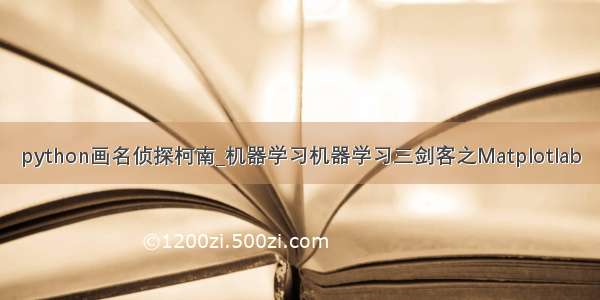
原标题:Python实战爬B站 | 帮你梳理柯南主线剧情+弹幕
文末扫海报二维码领【本文完整代码】
皖渝 | 作者
凹凸数据 | 来源
https://mp./s/kVsQmTIh-okzH9WZRBC0FA
1
爬取介绍
利用Chrome浏览器抓包可知, B站的弹幕文件以XML文档式进行储存,如下所示(共三千条实时弹幕)
其URL为:
不难看出, CID则是对应着各个视频的ID,接下来用 正则提取即可。
完整爬取代码记得添加【小数】领取哦~
最终的全部弹幕文件都在桌面的"柯南"文件下:
注:这里共爬取到980个弹幕文件。【B站的柯南自941集后就跳到994集(大会员才能观看的)。虽然目前更新到1032话,但并没有1032集内容,如下图所示】
2
弹幕可视化
1.主要人物讨论总次数分析
统计人数总次数
注: role.txt是主要人物名文件(需考虑到弹幕一般不会对人物的全名进行称呼,多数使用的是昵称,否则可能与实际情况相差较大。)
import jieba
import os
import pandas aspd
os. chdir( 'C:/Users/dell/Desktop')
jieba.load_userdict( 'role.txt')
role=[ i.replace( 'n', '') fori in open( 'role.txt', 'r',encoding= 'utf-8').readlines]
txt_all=os.listdir( './柯南/')
txt_all. sort(key=lambda x: int( x. split( '.')[ 0])) #按集数排序
count= 1
def role_count:
df = pd.DataFrame
forchapter in txt_al l:
names={}
data=[]
with open( './柯南/{}'.format(chapter), 'r',encoding= 'utf-8') asf:
forlinein f.readlines:
poss=jieba.cut( line)
forword in pos s:
ifword in role:
ifnames. get(word) isNone:
names[word]= 0
names[word]+= 1
df_new = pd.DataFrame.from_dict(names,orient= 'index',columns=[ '{}'.format( count)])
df = pd.concat([df,df_new],axis= 1)
print( '第{}集人物统计完毕'.format( count))
count+= 1
df.T.to_csv( 'role_count.csv',encoding= 'gb18030')
可视化
import numpy asnp
import matplotlib.pyplot asplt
plt.rcParams[ 'font.sans-serif']=[ 'kaiti']
plt.style.use( 'ggplot')
df=pd.read_csv( 'role_count.csv',encoding= 'gbk')
df=df.fillna( 0).set_index( 'episode')
plt.figure(figsize=( 10, 5))
role_sum=df.sum.to_frame.sort_values(by= 0,ascending=False)
g=sns.barplot(role_sum. index,role_sum[ 0],palette= 'Set3',alpha= 0.8)
index=np.arange( len(role_sum))
forname, countin zip( index,role_sum[ 0]):
g.text(name, count+ 50, int( count), ha= 'center',va= 'bottom',)
plt.title( 'B站名侦探柯南弹幕——主要人物讨论总次数分布')
plt.ylabel( '讨论次数')
plt.show
虽说是万年小学生,柯南还是有变回新一的时候,且剧情也并不只是"找犯人—抓犯人"。接下来从 数据的角度来,扒扒一些精彩剧情集数。
2.柯南变回新一集数统计
考虑到部分集数中新一是在回忆中出现的,为减少偏差,将讨论的阈值设为250次, 绘制如下分布图:
其讨论次数结果及剧集名如下表所示:
有兴趣的朋友可以码一下,除235集外,均是柯南变回新一的集数。 相关代码如下:
df=pd.read_csv( 'role_count.csv',encoding= 'gbk')
df=df.fillna( 0).set_index( 'episode')
xinyi=df[df[ '新一']>= 250][ '新一'].to_frame
print(xinyi) #新一登场集数
plt.figure(figsize=( 10, 5))
plt.plot(df. index,df[ '新一'],label= '新一',color= 'blue',alpha= 0.6)
plt.annotate( '集数:50,讨论次数:309',
xy=( 50, 309),
xytext=( 40, 330),
arrowprops=dict(color= 'red',headwidth= 8,headlength= 8)
)
plt.annotate( '集数:206,讨论次数:263',
xy=( 206, 263),
xytext=( 195, 280),
arrowprops=dict(color= 'red',headwidth= 8,headlength= 8)
)
plt.annotate( '集数:571,讨论次数:290',
xy=( 571, 290),
xytext=( 585, 310),
arrowprops=dict(color= 'red',headwidth= 8,headlength= 8)
)
plt.hlines(xmin=df. index. min,xmax=df. index. max, y= 250,linestyles= '--',colors= 'red')
plt.legend( loc= 'best',frameon=False)
plt.xlabel( '集数')
plt.ylabel( '讨论次数')
plt.title( '工藤新一讨论次数分布图')
plt.show
以讨论次数最多的572集, 绘制词云图(剔除了高频词"新一",防止遗漏其他信息) 如下所示:
从图中可看出,出现频率较高地词有 整容、服部、声音、爱情等。(看来凶手是整成了新一的模样进行犯罪的,还有新兰的感情戏在里面,值得一看)
3.主线集数内容分析
主线剧情主要是围绕着组织成员(琴酒、伏特加、贝尔摩德)展开, 绘制分布图如下:
plt.figure(figsize=( 10, 5))
names=[ '琴酒', '伏特加', '贝姐']
colors=[ '#090707', '#004e66', '#EC7357']
alphas=[ 0.8, 0.7, 0.6]
forname,color,alpha in zip(names,colors,alphas):
plt.plot(df. index,df[name],label=name,color=color,alpha=alpha)
plt.legend( loc= 'best',frameon=False)
plt.annotate( '集数:{},讨论次数:{}'.
format(df[ '贝姐'].idxmax, int(df[ '贝姐']. max)),
xy=(df[ '贝姐'].idxmax,df[ '贝姐']. max),
xytext=(df[ '贝姐'].idxmax+ 30,df[ '贝姐']. max),
arrowprops=dict(color= 'red',headwidth= 8,headlength= 8)
)
plt.xlabel( '集数')
plt.ylabel( '讨论次数')
plt.title( '酒厂成员讨论次数分布图')
plt.hlines(xmin=df. index. min,xmax=df. index. max, y= 200,linestyles= '--',colors= 'red')
plt.ylim( 0, 400)
#输出主线剧集
mainline= set( list(df[df[ '贝姐']>= 200]. index)+ list(df[df[ '琴酒']>= 200]. index)) #伏特加可忽略不计
print(mainline)
从上图分析可知,组织成员的行动基本一致,其中贝姐(贝尔摩德)的人气在三人中是较高的,特别是在375集(与黑暗组织直面对决系列),讨论次数高达379。
此外, 统计其讨论次数大于200次的集数,结果如下:
以讨论次数最高的375集为内容, 绘制词云图(剔除了高频词"贝姐",防止遗漏其他信息) 如下:
从图中可知, 天使、琴酒、干妈、心疼、狙击手等词汇出现频率较高。从词频较低的败北主线中可以看出,这次酒厂行动应该是失败告终。
3
人物形象网络分析
1.合并txt文件
为尽可能反映出弹幕观众对人物形象的描述,考虑到一集弹幕共3000条,为 减少运行成本,这里仅选取 特定人物讨论次数最多的20集合并后再进行分析。
import os
import pandas aspd
df=pd.read_csv( 'role_count.csv',encoding= 'gbk')
df=df.fillna( 0).set_index( 'episode')
huiyuan_ep= list(df.sort_values(by= '灰原哀',ascending=False). index[: 20])
mergefiledir = 'C:/Users/dell/Desktop/柯南'
file= open( 'txt_all.txt', 'w',encoding= 'UTF-8')
count= 0
forfilename in huiyuan_ep:
filepath=mergefiledir+ '/'+str(filename)+ '.txt'
forlinein open(filepath,encoding= 'UTF-8'):
file.writelines( line)
file. write( 'n')
count+= 1
print( '第{}集写入完毕'.format( count))
file. close
2.人物形象可视化
借助 共现矩阵的思想,即 同一句话中出现两个指定的词则计数1。
指定起始点Source为灰原哀, 代码如下所示:
importcodecs
importcsv
importjieba
linesName=[]
names={}
relationship={}
jieba.load_userdict( 'role.txt')
txt=[ line.strip forline inopen( 'stopwords.txt', 'r',encoding= 'utf-8')]
name_list=[ i.replace( 'n', '') fori inopen( 'role.txt', 'r',encoding= 'utf-8').readlines]
defbase(path):
withcodecs.open(path, 'r', 'UTF-8') asf:
forline inf.readlines:
line=line.replace( 'rn', '')
poss = jieba.cut(line)
linesName.append([])
forword inposs:
ifword intxt:
continue
linesName[ -1].append(word)
ifnames.get(word) isNone:
names[word]= 0
relationship[word]={}
names[word]+= 1
returnlinesName,relationship
defrelationships(linesName,relationship,name_list):
forline inlinesName:
forname1 inline:
ifname1 inname_list:
forname2 inline:
ifname1==name2:
continue
ifrelationship[name1].get(name2) isNone:
relationship[name1][name2]= 1
else:
relationship[name1][name2]+= 1
returnrelationship
defwrite_csv(relationship):
csv_writer2=open( 'edges.csv', 'w',encoding= 'gb18030')
writer=csv.writer(csv_writer2,delimiter= ',',lineterminator= 'n')
writer.writerow([ 'Source', 'Target', 'Weight'])
forname,edges inrelationship.items:
fork,v inedges.items:
ifv> 10:
writer.writerow([name,k,v])
csv_writer2.close
if__name__== '__main__':
linesName,relationship=base( 'txt_all.txt')
data=relationships(linesName,relationship,na
注:其中,stopwods.txt为停止词文件,role.txt为人物昵称文件
将生成的文件导入Gephi,得到如下人物形象图:
线条越粗的线,代表该人物特征越明显。不难看出,大家对于哀酱的评价主要是美腻、可爱、心疼。
再做一张琴酒的:
哈哈哈,大家对琴酒的评价就比较逗逼了, 变态,痴汉,聪明啥都有。你以为的琴酒,实际上的琴酒(手动滑稽
以上就是本次python实战的全部内容!
爱数据·10月职场专题直播
直播主题:第3季度 · 岗位调研——数据领域城市岗位调研报告
内容剧透:
各地区数据领域岗位招聘现状
数据领域职场人才需求情况调研
数据分析求职新方向
直播时间:10月29日 明晚20:30
扫码回复
预约直播
即可0元领取直播入口!返回搜狐,查看更多
责任编辑:






![[推荐]古屋幽猫的写事作文1200字](https://1200zi.500zi.com/uploadfile/img/2024/07/26/0eef64ff08c70bbc943d19a30b921375.jpg)






